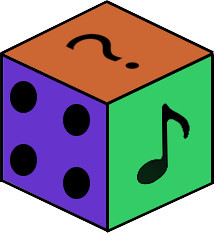 |
|
 |
Included in Meet set/collection.
A family of games based on image interpretation. Good usage for inspire cards.
Preparation
You'll need interpretable images to play. See: Inspire cards for hints. The amount you need depends on a chosen variant and number of players. 32 cards will be enough for any example game presented below for 7 participants or less.
The examples will show cards with colours. The option of interpreting colours is available for these games, but might make it hard.
Common rules (for all games)
Card patterns, starting positions, rules and timing of movement as well as gaming goals will be defined by specific rulesets, but more is shared by all titles from Follow the Images family:
- At the beginning of the game, shuffle the deck and deal cards to form a set pattern at the table.
- The pattern will serve as a board — at any moment of the game you will be "at" some card. No pawns or other indicators of position will be used — remember where you are.
- Interpret musically the card that you occupy — this is treated as a signal of your position to other Players. But don't be too obvious with your signal — it's bad for music!
- Move from one card to another, but make music fluent and without clearcut stops in between the images.
- Play music for all the time of the game.
- The success with the gaming goal will be evaluated in the discussion after the game.
During the game, communication (verbal and non-verbal) is not allowed, apart from the played music.
Also, no strategic pre-agreements should be made — factors not defined by the ruleset (e.g. timing or direction of movement depending on a variant) should be decided during the playing, with regards to the preferred musical outcome.
Example rulesets

One Round Together
Pattern: Circle of 8 cards with the last dealt card marked by moving it a bit out of the circle.
Start: Everyone starts at the marked card. It's best if the first sound is done by the instrument that group decides that fits best to the image on the card.
Movement: Players move clockwise to consequent image cards.
Timing: Not signalled nor coordinated from outside — should depend on the music — finding the proper timing of the move is one of the goals of of this game.
End: Move full circle to end the piece at the same card you started.
Goal: At any moment during the game Players should try to stay together at the same card (don't spread to a distance more than one card apart).

Even Divide
This game works better with the even amount of Players. Choose the Player that will signal the end of the first turn and make sure you can follow the order of Players (e.g. if you sit in a circle, go clockwise).
Pattern: Pyramid with 6 cards at the base.
Start: Start at the single card at the top of the pyramid.
Movement: On every round move individually one step down the pyramid to the neighboring card (down-left or down-right).
Timing: Every round signaled by the next Player according to the order you established before the game.
End: Everyone should arrive at the bottom of the pyramid at the same time to end the piece soon after. Remember where you ended.
Goal: Look at the bottom of the pyramid and check 3 left cards and 3 right cards. Your task is to have at the end equal amount of Players in both halves (±1 if odd number).
If you have a short hourglass (~1 min), you can treat it as a signal for a step down. One player will be tasked with taking care for turning the hourglass.

Make Way
Pattern: Depends on the amount of participants. The example is for 5 or 6 Players and this number is optimal.
Start: Starting cards in the example are are adjacent to only one another card (6 of these visible). These few cards should be dealt first and after they are on a table every Player will pick and announce one of the cards as his or her starting point before the rest of the pattern is dealt. Try to pick the image that best suits your instrument. For 7-8 players extend your Pattern downward with another two layers with 8 cards total, etc.
Movement: You move between neighbouring cards in any direction you want. Timing of movements is free.
End: Ends when every Player moves from his or her starting point on one side of the pattern to a freely chosen starting point on the other side of the pattern. Your target point should not be at the same level as your starting point (e.g. red can aim for blue or pink, but can't end in black although might visit it on the way).
Goal: You should never be at the same card as any other Player (if you'll not hear it, discussion will show if you won or not). If that "hit" happens to you, get back to your starting point.
Variants
For these type of games discussion after the play is very useful. During that discussion, consider finding other sub-games with similar shared rules. Possibilities are endless, and if you find something fun to play, please add it to the library, so we can test these versions.
Click buttons to add all relevant tags:
no-props board dice score props
free-improv on-off (constellations) in-genre algorithm ambient loop spatial minimal
dance draw (art) gestures guess memory kids
composers events insert narrative quick random role-play simple
dimensions rhythm speeding-up timed tonal
acapella found (+preparation) keyboard words
Finish tagging (_game) (regular library entries)
Finish tagging (_non-game) (rare, mostly to hide the above buttons)
